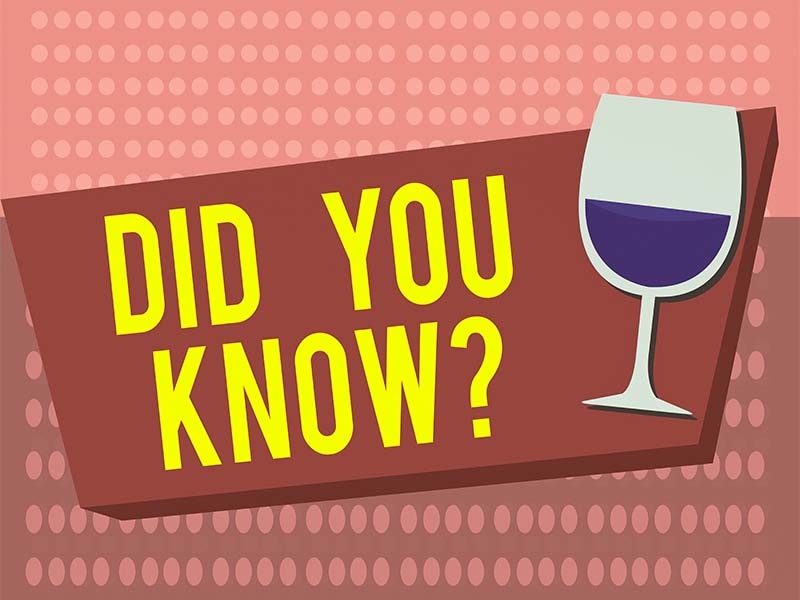Wine Trivia
- Posted on
- Posted in Cabernet Sauvignon, chardonnay, maderia, tempranillo
- 0

1. There are 750 milliliters or 25.4 ounces in a bottle of wine. The number of glasses in a bottle depends on the size of your glass and how big a pour you give yourself.
- Wine bottles come in varied sizes. Here are the names and sizes in ascending order: 375 ml Demi or Half (holds one-half of the standard 750 ml size), 750 ml Standard (common bottle size), 5 L Magnum (two standard 750 ml bottles, 3.0 L Double Magnum (four standard 750 ml bottles), 4.5 L Jeroboam (six standard 750 ml bottles but for sparkling wines a Jeroboam is 3 L), 4.5 L Rehoboam (sparkling wine bottle with six standard 750 ml bottles), 6.0 L Imperial aka Methuselah (eight standard 750 ml bottles), 9.0 L Salmanazar (twelve standard 750 ml bottles or a full case of wine), 12.0 L Balthazar (sixteen standard 750 ml bottles), 15.0 L Nebuchadnezzar (twenty standard 750 ml bottles), and 18.0 L Solomon aka Melchoir (twenty four standard 750 ml bottles).
- There are an average of 600-800 grapes in every bottle of wine.
- There are 60 gallons of wine in a standard barrel, and that yields about 300 bottles of wine, which is 25 cases. A barrel that holds 126 gallons is called a butt. Now, that’s a buttload of wine.
- The average age of an oak tree harvested to make oak barrels in France is about 110-150 years.
- French oak barrels are more expensive than American oak barrels because of the grain. French oak has a looser grain and as such the wood needs to be split along the natural grains to remain watertight. American oak grain is tighter, and it can be sawed into staves rather than split leaving left waste.
- Most corks come from the cork forests in Portugal. A tree is harvested for cork every 9 years. There is a single tree called “The Whistler” that can produce enough cork for 100,000 bottles each time it is harvested.
- The oldest known winery is in Armenia, and dates back to 4100 BCE.
- The early Phoenicians were responsible for spreading wine across the Mediterranean and introducing to the Greeks. The Greeks and Romans did their part too. They even dedicated gods to their love of the fermented grape—Dionysus and Bacchus.
- Madeira was the wine used to toast both the signing of the Declaration of Independence and at George Washington’s inauguration.
- The two U.S. presidents who attempted to grow grapevines were Thomas Jefferson and George Washington. Unfortunately, neither was successful, but luckily, they had day jobs.
- Sir Winston Churchill was a big champagne drinker. By his own estimates, he drank over 42,000 bottles of Pol Roger Champagne in his lifetime. That is an average of 1.5 a day over his adult life.
- The place with the highest wine consumption per capita is Vatican City.
- Speaking of champagne, a cork can fly out of a bottle at up to 50 miles per hour.
- There are approximately 49,000,000 bubbles in a bottle of champagne. We aim to help free them.
- A vertical tasting means trying the same wine from different vintage years, side-by-side. If the grape source, grape percentages, and winemaker are across those vintages then the difference would be mostly attributable to the growing season each year.
- A blind tasting means sampling wines whose identity is hidden. The ultimate goal is to deduce the grape and region where the wine is produced, and an approximate vintage or age. The pros may also state the specific wine producer, vineyard, and year.
- There are 1,300 grape varieties that are used to make wine in commercial production around the world. Imagine how many varieties are out there and are made only in small quantities and consumed locally.
- Cabernet Sauvignon is the most planted variety in the world followed by Merlot, Airén (Spanish grape used to make brandy), Tempranillo, and Chardonnay.
- Most wines are not vegan or vegetarian because egg whites or fish bladder may be used to remove sediment (called fining) from the wine yielding a clearer wine.
- Wine may not technically be gluten free, because often a barrel is sealed with a paste made from flour and water.
- There are more sulfites in white wines then red wines, as the winemaker wants to prevent oxidation. Think of a cut apple on your counters and how quickly it oxidizes. Dried fruits can contain 5 times the amount of sulfites than a bottle of wine.
- Red wine has tannins that are antioxidants called revesterol. This has been shown to reduce the risk of heart disease by helping to maintain healthy cholesterol levels.
- As white wine ages, it gets darker. As red wine ages, it gets lighter.
- The best wine for you is the wine you like!

Comments
Be the first to comment...